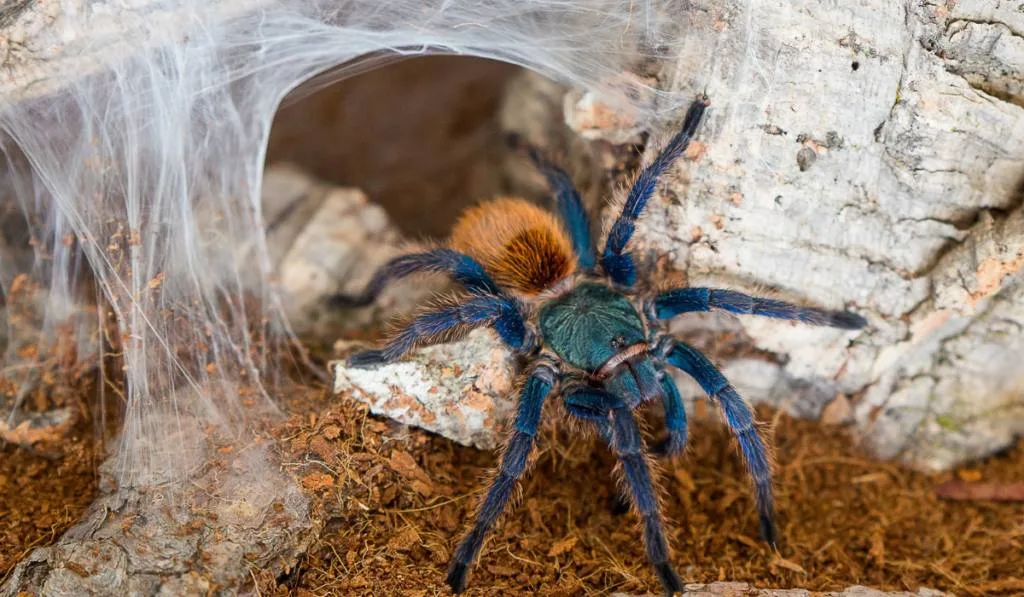The tarantula invokes a lot of different feelings in people. To some, it is a docile and long-term companion that is very low maintenance and cheap to look after. For others, it is the diesel fuel that powers their every nightmare and the personification of terror.
The truth lies somewhere in the middle, though what cannot be understated is their varied and oft-times surprising appetite when it comes to other animals.
If you’ve ever wondered what would happen if there was some lightweight grudge match between the two top contenders of the pint-sized predator world, well, then you’ve come to the right page.
Today we will be discussing exactly why tarantulas tend to avoid eating scorpions, how often they come into contact, and all the different food groups in the arachnid food pyramid.
By the end of this article, you will not only be able to answer the age-old question of tarantula vs. scorpion, but also describe just why and how the tarantula may not come out on top.

Table of Contents
Will a Tarantula Eat a Scorpion?
You may want to sit down for this one, as it is a question that has several answers. There is a massive variety of different species and sizes of both tarantula and scorpion that will come under the microscope as we look over just how exactly a tarantula would go about eating a scorpion.
The Average Tarantula
So imagine you are a person who does not have the benefits of your local fast-food restaurants or grocery chains. Now you are given a large knife to find your dinner for the night, and there are plenty of options. Of these options are a bunny, a deer, a very slow and inattentive cow, and another human with a knife.
This is sort of the situation that the tarantula is in.
While it could potentially kill a scorpion, the cost feels far too high and the risk is too great. What the tarantula and scorpion would rather do, is give each other a wide berth altogether.
The ease in catching and killing other prey is far more manageable than trying to take out the insect equivalent of a venomous armored car.
The Arizona Tarantula
Every species has an outlier, and deep in the desert of the Copper State lies a nocturnal predator that is more than able to claim a scorpion for dinner. This is, however, conditional. They tend to favor smaller scorpions and typically catch their prey in web traps they lay throughout the soil.
Researchers have also noticed that if the scorpion lands the first hit or sting, the tarantula will usually scamper off somewhere.
The tarantula is an intelligent opportunist and is driven by instinct, not ego. These clever hunters are not going to risk their lives if they can avoid it and would rather secure a safer, less deadly kill if the option exists.
So while the Arizona tarantula is a known exception, even it has its limits as to what it will go after.

What Does A Fight Look Like?
While it is very uncommon for the two to start getting aggressive with one another as they tend to avoid interaction with the other, they will get into scuffles on occasion.
This usually is due to one stepping on the other predators perceived ‘turf’ or if one side decides the other looks like it would be a good meal. So grab a box of popcorn while I get to live my dream of describing the advantages and disadvantages of a tarantula going twelve rounds with a scorpion.
Advantages of a Tarantula
Typically speaking, the tarantula will almost always outsize the scorpion by a considerable amount. On average they tend to be the larger of the two insects.
On top of this, some researchers believe that tarantulas have a natural resistance to venoms, including that found within a scorpion’s pincer. This is not to say that the venom will not be painful or effective against the eight-legged sparring partner, it simply means that it will likely not be fatal.
The tarantula carries some of the most effective piercing tools in the animal kingdom, fangs made of very durable chitin, a substance that makes up the protective layer of most armored insects (including scorpions).
There have even been studies that found that in areas with a large population of tarantulas, scorpions were noticeably not present, leading people to believe that tarantulas will go after them in certain cases.
Disadvantages of a Tarantula
Well, at the risk of stating the obvious, they are a lot more fragile than a scorpion. Their delicate body is susceptible to amputation or mutilation if they come into contact with the dangerous pincers of their adversary.
On top of this, it seems to be the case that whoever stings the other cleanly first is typically the winner on the exceedingly rare chance that these two do come into conflict with one another.
Another problem that will arise with tarantulas is that they tend to go after smaller scorpions, probably because they are perceived as weaker. This is not entirely the case, though. The smaller the scorpion is the more deadly its venom, with scorpions being responsible for over 3,000 human fatalities annually.

Advantages of a Scorpion
Scorpions all come with a durable chitin exoskeleton that is hard to pierce for most predators, tarantulas included.
This is on top of the fact that they can whip out their stinger at a speed of up to fifty-one inches per second make them an uncomfortably painful challenge for any ambitious spider looking to attack one.
The final nail in the coffin is the two front-facing pincers they carry that can easily rip and tear apart prey, including the vulnerable body of a tarantula.
They also possess much more potent venom that kills a regrettable number of humans every year, while there have been no human deaths from a tarantula bite in recorded history. Scorpions in Australia have even been documented to prey upon wolf spiders along with other smaller breeds.
After you look at all the facts behind these two miniature monsters you start to understand why they are better left giving each other their space.
Disadvantages of a Scorpion
Scientists have found that some tarantulas may have developed a mutation that allows them to become resistant to scorpion venom.
To make matters worse, most tarantulas rely on prey falling into traps or being surprised by an arachnid ambush before making their presence known. If a scorpion is caught unaware or with one of its four pairs of walking legs in a web, it might be in for a very rough night.

The Outcome
What has become exceedingly apparent in my research is that while the tarantula will typically eke out a fight to survive, it really goes on a case-by-case basis.
How big each creature is, how quick they are, and how much of a natural advantage they have will play a huge part in who will come out on top.
If you were planning to change up your tarantula’s diet to incorporate giant forest scorpions, I’d recommend sticking to grasshoppers.
Final Word
Tarantula’s will on occasion prey upon scorpions, though it is not normal and probably very unlikely unless it is the Arizona tarantula.
When it comes to who will win as the old saying goes, “It’s not the size of the goliath birdeater tarantula in the fight, but the size of the fight in the goliath birdeater tarantula.”
So now you can rest easy knowing the answer to a question that has eluded humanity since the dawn of time!
References:
- https://imb.uq.edu.au/blog/2021/06/scorpion-or-tarantula-which-would-win-fight
- https://neeness.com/do-tarantulas-eat-scorpions/#Can_a_scorpion_and_a_tarantula_live_together
